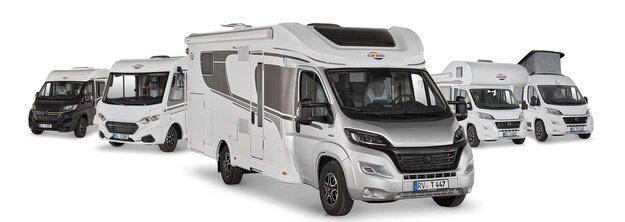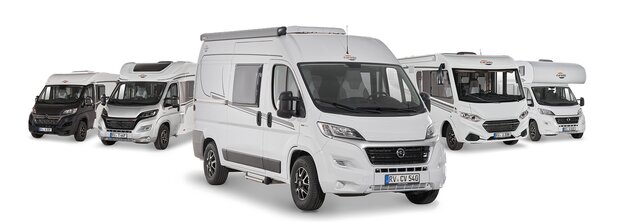Legal notes on weight-related information
The weight specifications and tests for motorhomes are uniformly regulated throughout the EU in EU Implementing Regulation No. 2021/535 (until June 2022: EU Implementing Regulation No. 1230/2012). We have summarised and explained the key terms and legal requirements from this regulation for you below. Our dealers and the Carado configurator on our website offer you additional assistance in configuring your vehicle.
1. Technically permissible maximum laden mass
The technically permissible maximum laden mass of the vehicle (e.g. 3,500 kg) is a mass specification set by the manufacturer which the vehicle must not exceed. Information on the technically permissible maximum laden mass of the model you have chosen can be found in the technical data. If the vehicle exceeds the technically permissible maximum laden mass in everyday driving, this constitutes an administrative offence which may result in a fine.
2. Mass in running order
In simple terms, the mass in running order is the basic vehicle with standard equipment plus a legally fixed standard weight of 75 kg for the driver. This essentially includes the following items:
- the unladen weight of the vehicle together with the bodywork, including operating fluids such as greases, oils and coolants;
- the standard equipment, i.e. all equipment items that are included as standard in the factory-fitted scope of delivery;
- the fresh water tank filled to 100 % in driving mode (driving fill according to manufacturer's specifications; 20 litres) and an aluminium gas cylinder filled to 100 % with a weight of 16 kg;
- the fuel tank, which is 90 % full, including fuel;
- the driver, whose weight – regardless of the actual weight – is generally specified as 75 kg in accordance with EU law.
Information on the mass in running order can be found for each model in our sales documents. It is important to note that the value for mass in running order given in the sales documents is a default value determined in the type-approval procedure and verified by the authorities. It is legally permissible and possible for the mass in running order of the vehicle delivered to you to deviate from the nominal value stated in the sales documents. The legally permissible tolerance is ± 5 %. In this way, the EU legislator accounts for the fact that certain fluctuations in the mass in running order occur due to variations in the weight of supplied parts as well as due to processes and weather conditions.
These weight deviations can be illustrated by means of an example calculation:
- Mass in running order acc. to sales documents: 2,850 kg
- Legally permissible tolerance of ± 5 %: 142.50 kg
- Legally permissible range of mass in running order: 2,707.50 kg to 2,992.50 kg
The specific range of permissible weight deviations can be found for each model in the technical data. Carado makes great efforts to reduce weight variations to the minimum that is unavoidable for production reasons. Deviations at the upper and lower end of the range are therefore very rare; however, they cannot be completely ruled out technically, even with all optimisations. The real weight of the vehicle and compliance with the permissible tolerance is therefore checked by Carado by weighing each vehicle at the end of the line.
3. Mass of the passengers
The mass of the passengers is set a standard value of 75 kg for each seat provided by the manufacturer, regardless of the actual weight of the passengers. The mass of the driver is already included in the mass in running order (see no. 2 above) and is therefore not included again. In the case of a motorhome with four permitted seats, the mass of the passengers is therefore 3 * 75 kg = 225 kg.
4. Optional equipment and actual mass of the vehicle
Optional equipment (also: additional equipment) includes, according to the legal definition, all optional equipment parts not included in the standard equipment which are fitted to the vehicle under the responsibility of the manufacturer – i.e. ex works – and can be ordered by the customer (e.g. awning, bicycle or motorbike carrier, satellite system, solar system, oven, etc.). Information on the individual or package weights of the optional equipment that can be ordered can be found in our sales documents. Optional equipment in this sense does not include other accessories that are retrofitted by the dealer or you personally after the vehicle has been delivered ex works.
The mass of the vehicle in running order (see no. 2 above) and the mass of the optional equipment fitted to a specific vehicle at the factory are together referred to as the actual mass. You will find the corresponding information for your vehicle after handover under item 13.2 of the Certificate of Conformity (CoC). Please note that this specification also represents a standardised value. Since the mass in running order – as an element of the actual mass – is subject to a legally permissible tolerance of ± 5 % (see no. 2), the actual mass may also deviate accordingly from the stated nominal value.
5. Pay-mass and minimum pay-mass
The installation of optional equipment is also subject to technical and legal limits: Only so much optional equipment can be ordered and fitted at the factory that sufficient free weight remains for baggage and other accessories (“pay-mass”) without exceeding the technically permissible maximum laden mass. The pay-mass is calculated by subtracting the mass in running order (nominal value according to sales documents, see no. 2 above), mass of the optional equipment and the mass of the passengers (see no. 3 above) from the technically permissible maximum laden mass (see no. 1 above). The EU regulations stipulate a fixed minimum pay-mass for motorhomes, which must remain as a minimum for baggage or other non-factory-fitted accessories. This minimum pay-mass is calculated as follows:
Minimum pay-mass in kg ≥ 10 * (n + L)
Where: “n” is the maximum number of passengers plus the driver and “L” is the overall length of the vehicle in metres.
For a motorhome with a length of 6 m and 4 approved seats, the minimum pay-mass is therefore e.g. 10 kg * (4 + 6) = 100 kg.
To ensure that the minimum pay-mass is maintained, there is a maximum combination of optional equipment that can be ordered for each vehicle model. In the above example with a minimum pay-mass of 100 kg, the total mass of optional equipment for a vehicle with four permitted seats and a mass in running order of 2,850 kg should not exceed 325 kg:
3,500 kg technically permissible maximum laden mass
- 2,850 kg mass in running order
- 3*75 kg mass of the passengers
- 100 kg minimum pay-mass
= 325 kg maximum permissible mass of optional equipment
It is important to note that this calculation is based on the default value for mass in running order as defined in the type-approval procedure, without taking into account the permissible weight deviations for mass in running order (see no. 2 above). If the maximum permissible value for the optional equipment of (in the example) 325 kg is almost or completely exhausted, an upward weight deviation can therefore result in the minimum pay-mass of 100 kg being met mathematically using the default value for the mass in running order, although in fact there is no corresponding load capacity. Here, too, an example calculation for a vehicle with four seats, whose real weighed mass in running order is 2 % above the nominal value:
3,500 kg technically permissible maximum laden mass
- 2,907 kg real weighed mass in running order (+ 2 % compared to the stated value of 2,850 kg)
- 3*75 kg mass of the passengers
- 325 kg optional equipment (maximum permissible value)
= 43 kg actual load capacity (< minimum pay-mass of 100 kg)
In order to avoid such a situation, Carado further reduces the maximum permissible weight of the total optional equipment that can be ordered on a model-specific basis. The limitation of optional equipment is intended to ensure that the minimum pay-mass, i.e. the legally prescribed free mass for baggage and retrofitted accessories, is actually available for the vehicle load capacity of the vehicles delivered by Carado.
Since the weight of a specific vehicle can only be determined when it is weighed at the end of the line, in very rare cases a situation may arise in which the minimum pay-mass at the end of the line is not guaranteed, despite this limitation of optional equipment. In order to guarantee the minimum pay-mass even in these cases, Carado will check together with your trade partner and you before delivery of the vehicle whether, for example, the vehicle is loaded up, seats are reduced or optional equipment is removed.
6. Effects of tolerances of the mass in running order on the pay-mass
Regardless of the minimum pay-mass, you should note that unavoidable production-related fluctuations in the mass in running order – both upwards and downwards – have a mirror-image effect on the remaining load capacity: If you order our example vehicle (see no. 3. above), for example, with optional equipment with a total weight of 150 kg, the calculated pay-mass based on the default value for the mass in running order is 275 kg. The load capacity actually available may deviate from this value due to tolerances and may be higher or lower. If the mass in running order of your vehicle is, for example, permissibly 2 % higher than stated in the sales documents, the load capacity is reduced from 275 kg to 218 kg:
3.500 kg technically permissible maximum laden mass
- 2.907 kg real weighed mass in running order (+ 2 % compared to the stated value of 2,850 kg)
- 3*75 kg mass of the passengers
- 150 kg optional equipment ordered for the specific vehicle
= 218 kg actual load capacity
As a precaution to ensure that the calculated pay-mass is actually given, you should therefore take the possible and permissible tolerances for the mass in running order into account when configuring your vehicle.
We also recommend that you weigh the laden motorhome on a non-automatic scale before each journey and, taking the individual weight of the passengers into account, determine whether the technically permissible maximum laden mass and the technically permissible maximum mass on the axle are observed.
Important tips for choosing your motorhome
When buying a motorhome, camper van or urban vehicle (hereafter: motorhome), it is particularly important to choose the right layout and an appealing design. In addition, weight also plays an essential role. Family, friends, optional equipment, accessories and baggage – space must be available for all of these. At the same time, there are legal and technical limits to the configuration and load. Every motorhome is designed for a certain weight, which may not be exceeded during driving. For motorhome buyers, this raises the question: How should I configure my vehicle to accommodate passengers, baggage and accessories according to my needs without the vehicle exceeding this maximum weight? In order to make this decision easier for you, we provide you below with a few tips that are particularly important when selecting your vehicle from our portfolio:
1. The technically permissible maximum laden mass…
… is a value set by the manufacturer which the vehicle may not exceed. Carado specifies a layout-related upper limit for the vehicle, which can vary from layout to layout (e.g. 3,500 kg, 4,400 kg). You can find the corresponding specification for each layout in the technical data.
2. The mass in running order…
... consists – to put it simply – of the basic vehicle with standard equipment plus a standard weight of 75 kg for the driver. It is legally permissible and possible for the mass in running order of your vehicle to deviate from the nominal value stated in the sales documents. The permissible tolerance is ± 5 %. The permissible range in kilograms is given in brackets after the mass in running order. In order to provide you with full transparency regarding possible weight deviations, Carado weighs each vehicle at the end of the line and informs your trade partner of your vehicle's weighing result for forwarding to you.
Detailed explanations on the subject of mass in running order can be found in the “Legal Information” section.
3. The permitted number of seats (including driver)…
… is determined by the manufacturer in what is referred to as the type-approval procedure. This results in what is referred to as the mass of the passengers. For this, a standard weight of 75 kg per passenger (without driver) is calculated.
Detailed explanations on the subject of mass of the passengers can be found in the “Legal Information” section
4. The manufacturer-specified mass for optional equipment…
… is a value set by Carado per layout for the maximum mass of optional equipment that can be ordered. This limit is intended to ensure that the minimum pay-mass, i.e. the legally prescribed free mass for baggage and retrofitted accessories, is actually available for the vehicle load capacity of the vehicles delivered by Carado. If, in exceptional cases, the weighing at the end of the line nevertheless shows that the actual load capacity falls short of the minimum pay-mass due to a permissible weight deviation, we will check together with your trade partner and you whether we should, for example, increase the load capacity of the vehicle, reduce the number of seats or remove optional equipment before delivering the vehicle.
Detailed explanations on the subject of the effects of the tolerances on the minimum pay-mass and the payload can be found in the “Legal Information” section.
5. The additional weight of optional equipment and packages...
... increases the actual mass of the vehicle (= mass in running order plus selected optional equipment) and reduces the pay-mass. The specified value shows the additional weight compared to the standard equipment of the respective layout. The total weight of the selected packages and optional equipment must not exceed the manufacturer-specified mass for optional equipment.
Weights ABC
1. What is the technically permissible maximum laden mass?
The technically permissible maximum laden mass of the vehicle (e.g. 3,500 kg) is a mass specification set by the manufacturer which the vehicle must not exceed. Information on the technically permissible maximum laden mass of the model you have chosen can be found in the technical data. If the vehicle exceeds the technically permissible maximum laden mass in everyday driving, this constitutes an administrative offence which may result in a fine.
2. What is the mass in running order?
The specified mass in running order is a default value defined in the type-approval procedure. Due to manufacturing tolerances, the actual weighed mass in running order may deviate from the value stated above. Deviations of up to ± 5 % of the mass in running order are legally permissible and possible.
In simple terms, the mass in running order is the basic vehicle with standard equipment plus a legally fixed standard weight of 75 kg for the driver. This essentially includes the following items:
- the unladen weight of the vehicle together with the bodywork, including operating fluids such as greases, oils and coolants;
- the standard equipment, i.e. all equipment items that are included as standard in the factory-fitted scope of delivery;
- the fresh water tank filled to 100 % in driving mode (driving fill according to manufacturer's specifications; 20 litres) and an aluminium gas cylinder filled to 100 % with a weight of 16 kg;
- the fuel tank, which is 90 % full, including fuel;
- the driver, whose weight – regardless of the actual weight – is generally specified as 75 kg in accordance with EU law.
3. What is the manufacturer-specified mass for optional equipment?
The manufacturer-specified mass for optional equipment is a value set by Carado per layout for the maximum mass of optional equipment that can be ordered. This limit is intended to ensure that the minimum pay-mass, i.e. the legally prescribed free mass for baggage and retrofitted accessories, is actually available for the vehicle load capacity of the vehicles delivered by Carado.
4. What is the mass of the passengers?
The mass of the passengers is set a standard value of 75 kg for each seat provided by the manufacturer, regardless of the actual weight of the passengers. The mass of the driver is already included in the mass in running order (see no. 2 above) and is therefore not included again. In the case of a motorhome with four permitted seats, the mass of the passengers is therefore 3 * 75 kg = 225 kg.
5. What is the minimum pay-mass and how can I calculate it?
The EU regulations stipulate a fixed minimum pay-mass for motorhomes, which must remain as a minimum for baggage or other non-factory-fitted accessories. This minimum pay-mass is calculated as follows: 10 * (n + L)
Where: “n” is the maximum number of passengers plus the driver and “L” is the overall length of the vehicle in metres.
For a motorhome with a length of 6 m and 4 approved seats, the minimum pay-mass is therefore e.g. 10 kg * (4 + 6) = 100 kg.
6. How do I have to consider the additional weight of optional equipment and packages?
The additional weight of optional equipment and packages increases the actual mass of the vehicle (= mass in running order plus selected optional equipment) and reduces the pay-mass. The specified value shows the additional weight compared to the standard equipment of the respective layout. The total weight of the selected packages and optional equipment must not exceed the manufacturer-specified mass for optional equipment.
7. How do I have to consider the Vario Seat?
The Vario seat is an optional 5th seat considered as a regular seat when calculating the minimum payload and passenger mass. To obtain a 5th seat, it must be ensured that the minimum payload is maintained and all other legal mass values are observed. For detailed information, please contact our trading partners.
8. Where do the terminologies come from and what is the legal base of the information?
To inform you as best as possible and transparently about the weights in our sales documents (print and digital), we are generally guided by the legally prescribed terminology. Since July 6, 2022, these have been specified in particular in the Implementing Regulation (EU) 2021/535 (previously: Regulation (EU) No. 1230/2012). The Implementing Regulation (EU) 2021/535 is made available online in the various EU languages: https://eur-lex.europa.eu/legal-content/DE/ALL/?uri=CELEX:32021R0535
9. What is the actual mass of the vehicle?
The mass of the vehicle in running order (see No. 2) and the mass of the optional equipment fitted to a specific vehicle at the factory are together referred to as the actual mass of the vehicle. You will find the corresponding information for your vehicle after handover under item 13.2 of the Certificate of Conformity (CoC). Please note that this information also represents a standardized value. Since the mass in running order – as an element of the actual mass – is subject to a legally permissible tolerance of ± 5% (see also no. 2), the actual mass may also deviate accordingly from the specified nominal value.
10. What remedies are available to me if, in an exceptional case, the actual load capacity at the end of the line falls short of the minimum pay-mass?
If, in exceptional cases, the weighing of your vehicle at the end of the line shows that the actual load capacity falls short of the minimum pay-mass due to an upward deviation of the permissible mass in running order, we will check together with you and the dealer before delivery of the vehicle whether we should, for example, increase the load capacity of the vehicle, reduce the number of seats, or remove optional equipment.
11. Why do I receive the actual weighed mass of the vehicle at the time of purchase? What does this mean for me?
In order to ensure the best possible transparency regarding the weights of our vehicles, we send the result of the weighing of the vehicle at the end of the line, i.e. information on the actual weighed mass of the vehicle as well as the remaining load capacity, to our dealers together with the invoice. They are required to pass on the information to you. If you have not received this information, you can contact your dealer and request it.
Our scales meet all legal and standard requirements and are regularly maintained, tested, and calibrated. Nevertheless, a slight tolerance is technically unavoidable. Moreover, the weight of the vehicle may vary slightly due to weather conditions and, for example, the associated absorption or release of moisture. The actual weight of the vehicle may therefore deviate from the actual weight communicated.
12. What do I have to consider in the case of a subsequent reduction of load capacity?
In the case of a reduction of load capacity, the technically permissible maximum laden mass is reduced and, due to the alternative chassis, the remaining load capacity is also reduced. Due to the change in the technically permissible maximum laden mass, reductions of load capacity may affect the permitted seats, the chassis, and the engine variant. If you have any questions, feel free to contact one of our dealers for advice.
If you wish a subsequent reduction of the load capacity of your vehicle, you can have this reduction carried out by the Technical Service. In your own interest, we recommend that you ensure compliance with all legal mass values at all times.
A reduction or increase of load capacity may result in changes to the legal requirements resulting from the new technically permissible maximum laden mass of the vehicle. This applies in particular to the German Road Traffic Act (StVO), the German Road Vehicle Registration Regulation (StVZO), toll regulations, and aspects of tax and insurance law. Therefore, inform yourself about the current legal situation with regard to the new technically permissible maximum laden mass of the vehicle and seek advice on this from the appropriate bodies.
13. What do I have to consider if I retrofit accessories to my vehicle or have them retrofitted by the dealer?
If you decide to retrofit accessories to the vehicle or have them retrofitted by the dealer, you should check the mass values of the accessories and of your vehicle beforehand and ensure that all legal mass values, in particular the technically permissible maximum laden mass of the vehicle and the technically permissible maximum laden mass on the axles, are still complied with if the accessories are taken into account. Please note that retrofitting accessories reduces your load capacity accordingly and affects the mass on the axle.
Storelocator
Enter your Postcode now and get in soon













